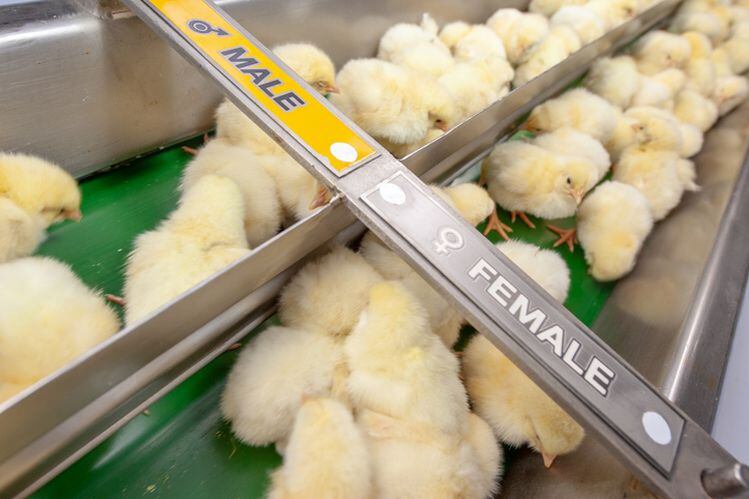The reasons are simple, says Yehuda Elram, co-founder and CEO of Israeli startup eggXYt, which recently hit the headlines after teaming up with Tropic Biosciences on a groundbreaking project to harness gene silencing technology to develop genetic resistance in chickens to avian flu.
The food industry, says Elram, raises two different breeds of chicken: broilers for meat, and layers for eggs. The problem is that male layers are of no use to the egg or meat industry: they can’t lay eggs, and there’s no market for their meat (too scrawny).
So we waste millions of dollars incubating billions of eggs, waiting for them to hatch, hiring trained ‘sexers’ to determine if they’re female or male, and then culling 50% of chicks the very day they’re born (around 6bn globally according to the USDA’s Foundation for Food and Agriculture Research).
It’s both gruesome (the chicks are typically killed via suffocation or grinding) and spectacularly bad economics (“It’s like manufacturing a billion chairs and then throwing half of them away,” observes Elram), and it’s sparked a global race to find a solution.
Counting your chickens before they hatch
The race is on to determine the sex (and effectively count our male chickens) before they hatch, and it’s heating up, with pressure to find a solution coming from multiple sources, including major egg producers (US-based United Egg Producers pledged to tackle the problem in 2016 although it claimed in summer 2020 that “a workable, scalable solution is not yet available”), to big CPG companies such as Unilever (which made similar commitments in 2014), to major retailers. Legislators in Switzerland, France, Spain, and Germany have also committed to ending the practice, which is clearly focusing minds.
USDA’s FFAR has also awarded a series of grants (part of the Egg-Tech Prize) to researchers developing technologies to accurately and quickly determine the sex of layer chick eggs before they hatch.

Sex determination techniques
Approaches to sex determination vary, from using 3D scanners and AI/machine learning to analyze the shape of eggs coupled with proton transfer reaction mass spectrometry (PTR-MS) to analyze sex-specific volatile organic compounds released by eggs; to MRI technology with AI to examine the organ development of embryos to detect physical differences between the males and females without penetrating the shell.
Other researchers are using multidimensional spectral mapping technology to identify the sex of eggs from 0-12 days of incubation by shooting different wave lengths of light at the egg and detecting refracted light patterns. AI would then be deployed to develop an optical fingerprint, or signature, that can determine the sex of eggs in fewer than five seconds.
Still others are using specialized sensor technology, gas chromatography mass spectrometry (GC-MS) and selected ion flow tube mass spectrometry (SIFT-MS) to analyze sex-specific volatile organic compounds; while some (notably Israeli firm SOOS Technology) are even exploring techniques to switch the sex of embryos from male to female, which if validated, would be a particularly exciting solution, although the technique is still in its infancy.
eggXYt: ‘Our technology is the only ‘day zero’ sexing technology which is scientifically proven’
The appeal of eggXYt’s solution – using CRISPR gene editing techniques to add a genetic marker to male eggs that glows when it goes through a scanner - is that it enables sex detection of chick embryos immediately after the eggs are laid and before they enter the 21-day incubation process, whereas most other approaches are only viable several days into the incubation process, in some cases 13 days into the 21-day cycle.
The most commercially advanced solution to the male chick culling problem – the technology behind Respeggt ‘no kill’ eggs, which are now sold in leading retailers in Europe including Carrefour, Rewe, Edeka, Penny, and Jumbo – for example, is not able to sex eggs until the 8th or 9th day of incubation, when a small drop of liquid is extracted from the hatching eggs and tested for a hormone only produced by females.

eggXYt, by contrast, can sex them on day zero, is non-invasive, cost-effective, fast, and 100% accurate, claims Elram: "Our advantage is that at this point, our technology is the only ‘day zero’ sexing technology which is scientifically proven.”
And this is a gamechanger “that will fundamentally change the economics of the poultry and egg industries,” he argues.
Above all, he says, “you’re saving lives, and giving supermarkets and consumers what they want, which is more ethical food.” From a sustainability perspective, meanwhile, you’re also dramatically reducing the carbon footprint of the industry (it takes a lot of energy to pointlessly incubate billions of eggs).
And from a pure economic perspective, he claims, it’s a no brainer: “We’re doubling the hatchery capacity, reducing incubation costs, and removing the need for human sexers and creating a whole revenue line: the sale of male eggs to other industries.”
USDA/FFAR: ‘Ideal’ solution would detect chick’s sex before incubation
According to a March 2019 press release from USDA’s foundation for food and ag research (FFAR) launching phase I of its Egg-Tech prize: “An ideal solution would determine a chick’s sex early in development, before hatcheries invest in incubation,” which is exactly what eggXYt is promising.
But it adds the caveat, “without genetically modifying the poultry genome.”
The GM factor
So will the ‘GM factor’ hinder the progress of eggXYt, which has thus far been funded by private investors and government grants from the EU and Israel and is now raising money for a Series A round?
Elram points out that the female eggs that go on to be incubated under the eggXYt approach are not impacted by CRISPR, which only applies a marker to the male eggs, which do not hatch, and would be diverted into other markets such as cosmetics or tanning.
“Only the male eggs are bio-marked, the female eggs are untouched and their DNA is 100% identical to the DNA of layers we know today.”

Notably, the criteria for phase II of the Egg-Tech prize, with submissions accepted in “early 2021,” stress the importance of speed, economic feasibility, accuracy (minimum 98%), and early detection (it sets 8 days into incubation as an upper limit) but do not reference genetic engineering, so it’s unclear if this means judges are now more open to technologies such as CRISPR.
eggXYt has struck a strategic relationship with TBG
While the term ‘genetic engineering’ can be something of a lightning rod given widespread consumer confusion and mistrust, the egg industry, the scientific community, and biotech investors understand the technology and its benefits, says Elram, who notes that the 2020 winners of the Nobel Prize for Chemistry were gene-editing pioneers Emmanuelle Charpentier and Jennifer Doudna.
There has also been some positive news lately on the regulatory front, with the UK's Dept for Environment, Food & Rural Affairs (DEFRA) opening a consultation on gene-edited crops and livestock on the grounds that changing current rules (which originate from the EU and make gene editing for crops and livestock almost impossible by regulating them as GMOs), would bring widespread benefits to consumers and farmers.
In the US, meanwhile, the FDA recently approved a first-of-its-kind intentional genomic alteration (IGA) in a line of domestic pigs, which may be used for food or human therapeutics, notes Elram.
Under a proposal announced in late December, meanwhile, regulation for bioengineered food animals would move from the purview of the FDA to the USDA.
He won’t comment on the progress of talks with potential egg industry partners, but confirms that eggXYt has struck “a strategic relationship with TBG, which is active through its operating companies in egg grading and hatchery equipment.”
Is there a food market for fertilized male eggs?
One interesting question if you can determine the sex of fertilized eggs prior to incubation, is why fertilized male eggs can’t go into the human food supply (which currently only uses unfertilized eggs), given that if they are not incubated, they won’t grow into chickens?
It’s a good question, says Elram, who believes that down the road consumers might be happy to eat them (as long as they are reassured that they are not going to crack open an egg to discover a half-formed chicken inside), but says he’s not addressed this issue with regulators given that there are ready markets for the male fertilized eggs in cosmetics and other markets such as tanning.




